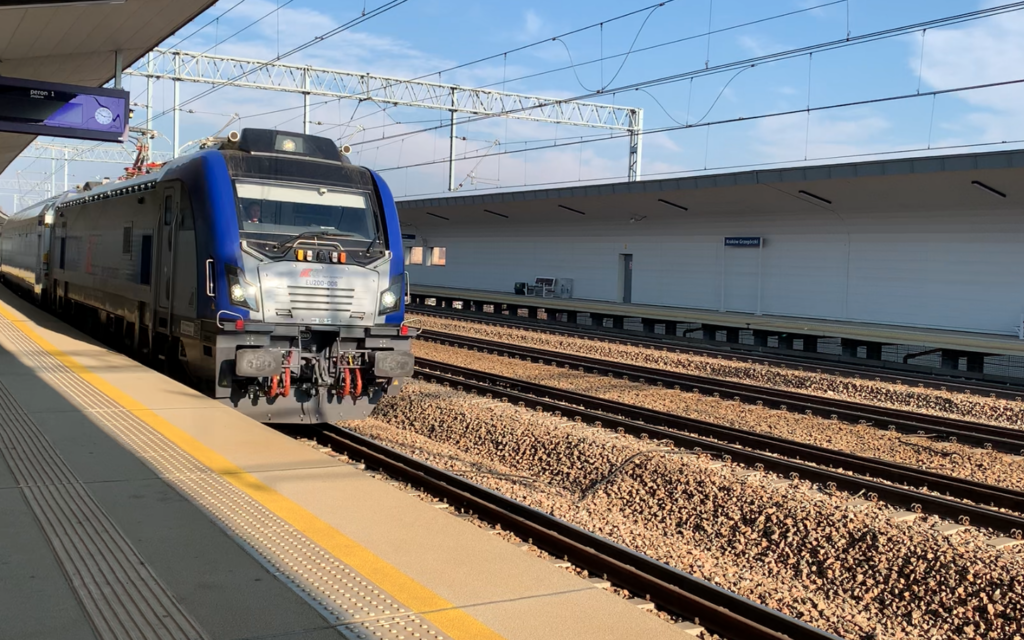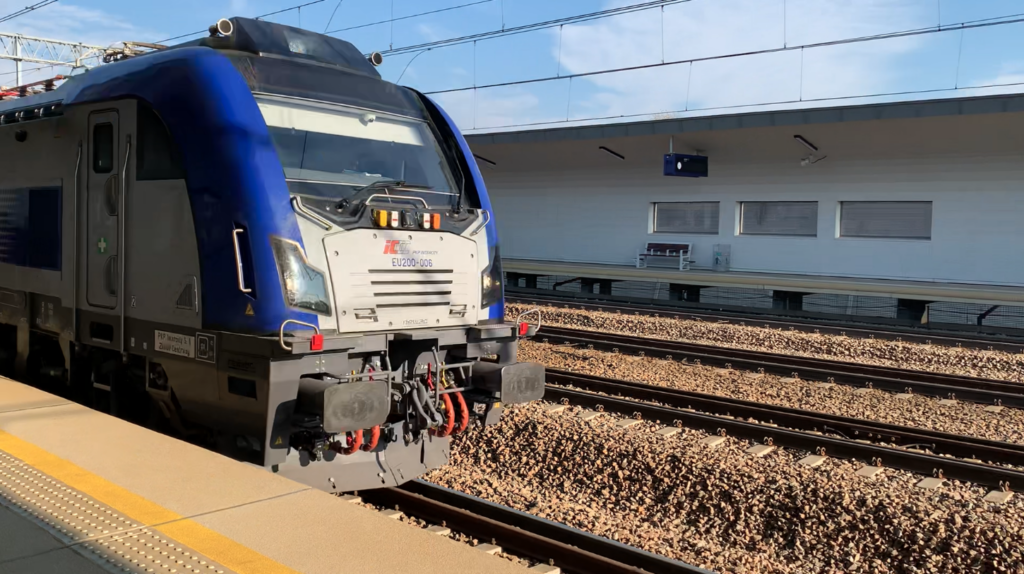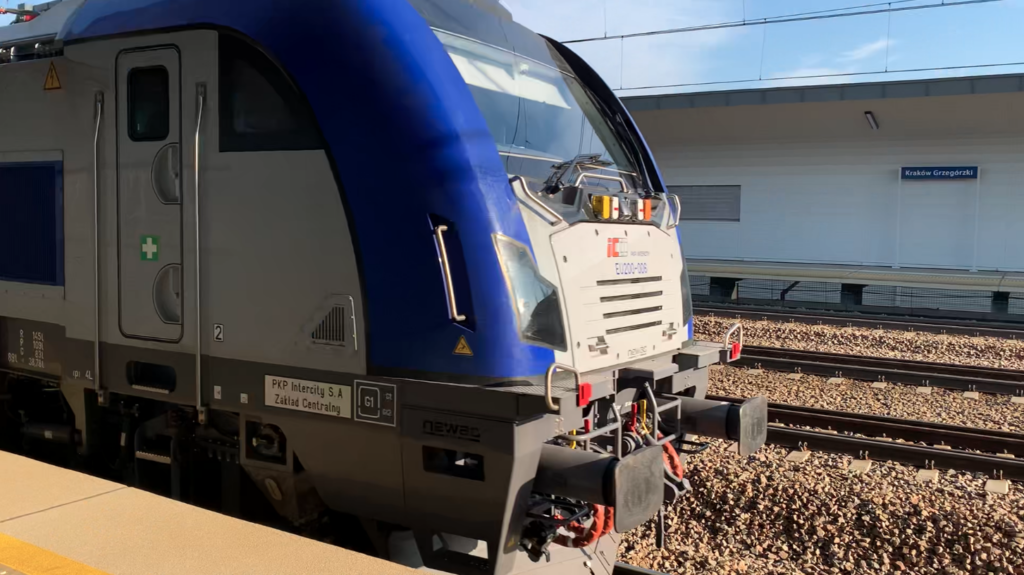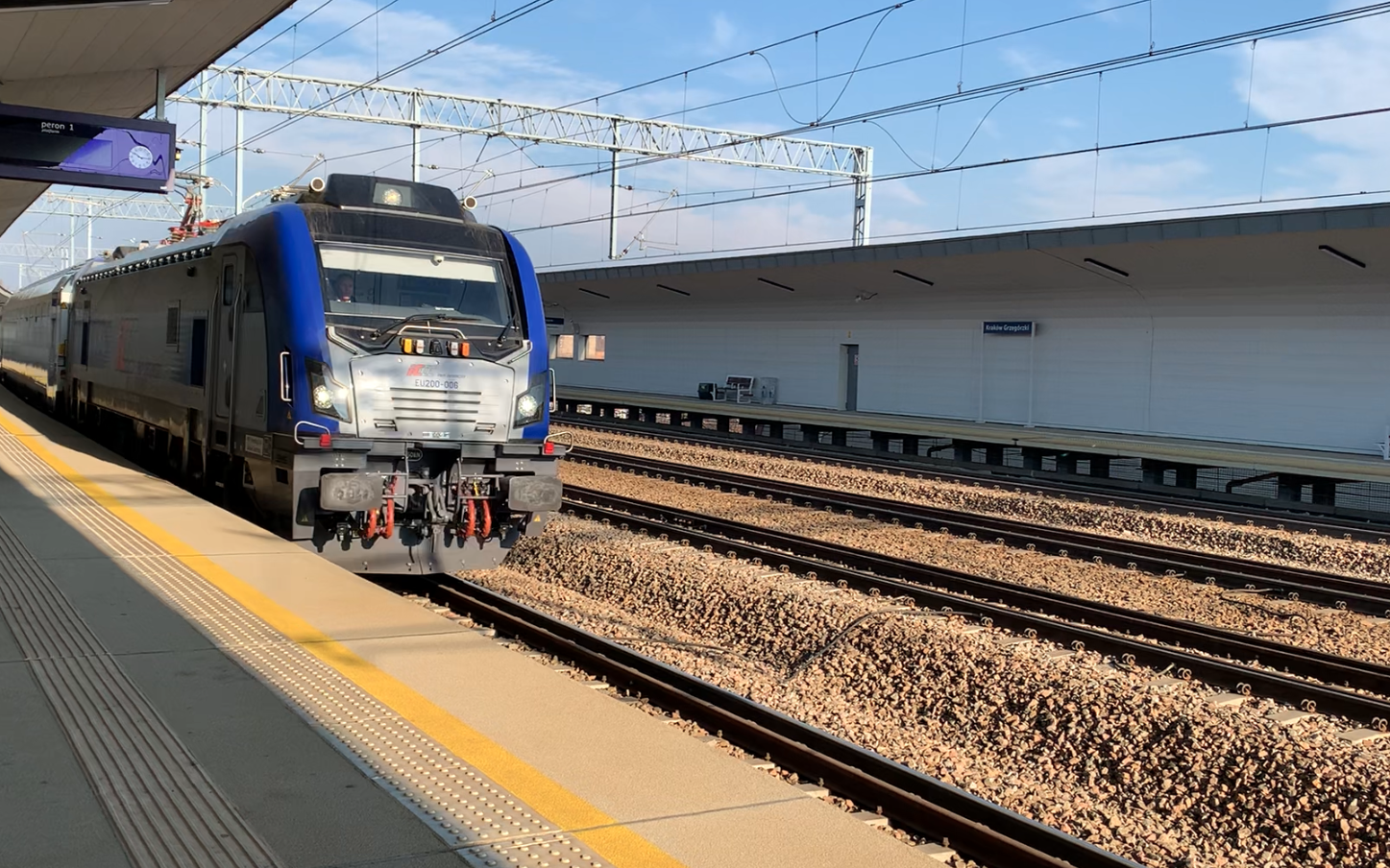Kraków 2024-11-18
Another speed record for a Polish rail vehicle. October 20, 2023.
On the night of October 19-20, 2023, a Polish electric locomotive reached a speed of 240 km/h. The Newag Griffin E4MSUa-001 locomotive on the test track traveled at a speed of 240 km/h, although the locomotive is to be certified for a travel speed of 200 km/h. The locomotive is multi-system, meaning it can be powered by voltages: 3kV DC, 15kV AC and 25kV AC. Thanks to this, the locomotive will be able to drive trains in the Czech Republic, Slovakia, Austria, Hungary, Germany. At the end of September 2023, tests of the new Newag Griffin E4MSUa-001 locomotive began on the Central Railway Main Line, at the height of Góra Włodawska. Achieving a speed of 240 km/h was one of the elements of certification. Currently, only the ED250 “Pendolino” electric multiple units run equally fast in Poland on a daily basis.
Newag Griffin EU200 Electric Locomotive. E4MSUa-006.
EU200-006, EVN: 91 515 370 082-7 (PL-PKPIC), factory number E4MSUa-006.



The NEWAG company from Nowy Sącz is a Polish manufacturer of modern electric, hybrid, diesel, (multi-system) locomotives, EZT, SZT, HZT and passenger cars. On October 22, 2021, the PKP InterCity carrier signed a contract for the delivery of 10 multi-system locomotives with an option for 5 additional vehicles, which was used in June 2023. On January 10, 2024, a contract was signed for 63 multi-system locomotives with a maximum speed of 200 km/h with an option for 32 additional ones.
Let us recall that NEWAG has already built EU160 electric locomotives, which were already capable of traveling at a speed of 200 km/h. The problem is that none of the Polish carriers placed an order for locomotives with a speed of 200 km/h. However, orders were placed for locomotives with a speed of 160 km/h, which were built and certified for such a speed. The EU160 locomotive works very well on the tracks. Many people believe that the EU44 Husarz (EuroSprinter ES64U4) locomotive, which was manufactured by Siemens, can hide.
The EU200 locomotive underwent tests in September 2023, on the test track in Żmigród. Work on the Griffin E4MSUa (EU200) locomotive was extended by one month, to 19 months, because it was necessary to replace the brake discs to meet the requirements.
The first locomotive certified for a speed of 200 km/h and delivered to PKP InterCity was the NEWAG EU200-006 locomotive. The entire contract for 15 EU200 locomotives amounted to PLN 388 million. On September 23, 2024, the NEWAG EU200-006 locomotive served the first passenger train of the carrier IC 1510/1 “Słowiniec” on the Warszawa Zachodnia – Gdynia Główna route. On September 26, 2024, the InterCity carrier already had nine EU200 series locomotives. All of these locomotives were already in operation by September 26, 2024. The introduction of EU200 type locomotives allowed for the effective use of modernized rail routes. The fact that the locomotive is multi-system allows it to be used abroad.
All locomotives are equipped with the European ETCS level 2 control system, which significantly increases safety standards on tracks. Here is a note. We are waiting for the times when, after railway tragedies, not only ordinary railwaymen, people of hard and responsible work, will be in the docks of the accused, but also directors and ministers will end up in courts.
EU200 locomotives also have a remote diagnostic system, allowing monitoring of the locomotive operation in real time. Currently (November 2024) Griffin ET200 locomotives are also to be approved for operation on foreign routes. First, the manufacturer NEWAG is trying to obtain homologation on the railway network in the Czech Republic and Slovakia. Then in countries such as Hungary, Austria and Germania. The homologation should be completed in 2026, unless the Germans block the process. Currently (November 2024) EU200 locomotives pull trains on routes such as from Warsaw to: Gdynia, Poznań, Wrocław, Katowice, Kraków, Zakopane. After receiving permits, they will run to Prague, Budapest, Vienna, and possibly Berlin. EU200 series locomotives have also entered replacement trains for the EZT ED250 “Pendolino”. Replacement trains with NEWAG EU200 locomotives are easily maintained in the timetable.
We must write that in 2024, PKP InterCity signed contracts for four important rolling stock projects, including two with NEWAG. The first for the purchase of 63 multi-system electric locomotives with the option of ordering another 32 vehicles and providing a 5-year maintenance service. This is the first such large order for one series of vehicles in the history of both the carrier and the manufacturer. The value of the contract is almost PLN 2.3 billion gross. An order for 46 single-system electric locomotives of the EU160 Griffin series is also in progress. The InterCity carrier is aiming to withdraw all used locomotives of the EU07 and EP07 series. It is worth remembering that NEWAG has outpaced the locomotive delivery schedule, engaging greater technical resources in their production. It can be said that a pseudo-production line has been launched.
Second contract; In July 2024, the InterCity carrier signed a contract with NEWAG for the purchase of 35 three-car HZT trains. 10-year service. The contract value is PLN 3.3 billion gross.
Locomotives are not everything. They must be passenger cars with a speed of 200 km/h. In August 2024, PKP InterCity and H. Cegielski – Fabryka Pojazdów Szynowych signed a contract for the delivery of 300 new cars. This order may be increased under the option right, by another 150 vehicles. The value of the contract is PLN 4.2 billion gross. The cars were designed in a completely new standard and will be able to run at a speed of 200 km/h, i.e. they will be cars for EU200 locomotives.
The second locomotive to enter service is the EU200-011. It was directed to the Gdynia – Gdańsk – Warsaw – Łódź – Częstochowa – Katowice route, as the IC TLK “Flisak” train No. 45103 and 54103. This was an ad hoc solution to intensify the training of additional mechanics.
Currently (December 2024), PKP Intercity has 50 EU160 locomotives and 15 EU200 locomotives in stock. These locomotives have significantly shortened the travel times of classic trains, which until now were pulled by locomotives at a maximum speed of 125 km/h.
Newag Griffin EU200 Electric Locomotive.
Newag Griffin is a series of Polish locomotives designed and manufactured by Newag, headquartered in Nowy Sącz. Newag Griffin is a new quality of traction vehicles adapted to the user’s requirements. A common feature of all Griffin vehicles is the Bo′Bo′ axle arrangement and the ability to drive various passenger and freight trains, with a maximum train weight of 3,200 tons. Griffin locomotives can be single-system electric, multi-system electric, electric with an additional combustion engine or combustion. This gives users a range of transport and technical possibilities.
The multi-system electric locomotive GRIFFIN is the first traction vehicle from the platform of four-axle electric and combustion locomotives, giving users a whole range of transport and technical possibilities. The locomotive is designed to pull freight trains weighing up to 3,200,000 kg at a speed of up to 140 km/h, and passenger trains at a speed of up to 200 km/h. NEWAG has high standards confirmed by certificates, including; International Railway Industry Standard IRIS (production, design, development and maintenance activities for locomotives) and PN-EN ISO 9001:2009, guaranteeing the highest European quality of the GRIFFIN locomotive.
The technical parameters of the GRIFFIN locomotive have been adapted to the individual needs of users. It is characterized by the highest level of safety, rich equipment, high driver comfort, and an intelligent energy management system. Thanks to its modular design, GRIFFIN is offered in several versions based on the maximum number of common components. Power supply of engines by converters built using IGBT technology, on-board diagnostic system with full visual information and data recording module, camera system, adaptation to the installation of ERTMS and GSM-R devices, these are just some of the basic features of the GRIFFIN locomotive. Meeting the EU and UIC requirements, the locomotive has not lost its next most important advantage, i.e. competitive price.
GRIFFIN locomotives pull freight trains weighing up to 3,200,000 kg, and passenger trains weighing up to 800,000 kg. Asynchronous, brushless motors were used, power supply by converters built using IGBT technology. The locomotive has: a microprocessor control system, an on-board diagnostic system with full visual information and a data recording module, an intelligent energy management system, a high technical availability index, adaptation to the installation of ERTMS and GSM-R devices, modular design, the highest level of safety, a spacious cabin compliant with EN 1527 standards, high comfort of the driver (mechanics), rich social equipment, care for environmental protection, high economics of use, attractive price. Drive unit: monoblock wheels with a nominal rolling diameter of 1250 mm, brake discs mounted on both sides of the wheel, asynchronous squirrel-cage traction motors with a power of 1400 kW each, independent cooling of each motor, helical gear, axle boxes: tapered bearings, speed and temperature sensors.
Spring system: First stage: two sets of coil springs mounted directly on both sides of the axle box of the wheel set. Second stage: a set of large-size spiral springs of the “flexicoil” type. Hydraulic shock absorbers to dampen vibrations.
Locomotive body: self-supporting welded construction, controlled crumple zones, driver’s cab safety cage, anti-climbing system, modular construction, three roof sections enabling easy access to the engine compartment, ergonomic, two-person locomotive cab, two-module air conditioning system, four cameras acting as rear-view mirrors, two cameras transmitting images of drawbar hooks and screw couplings, modern fire detection and extinguishing system. with its own control system and auto-drop system. Reliable high-speed circuit breaker UR26 by Secheron. Anti-interference filters. Traction transformer to reduce the voltage drawn from the 15kV/16.7Hz or 25kV/50Hz traction network to the voltage supplying the inverter inputs. Two drive power blocks, each containing two AC/AC converters – three-phase inverters with IGBT transistors and a DC/DC converter to regulate the electrodynamic braking force. Static converter with a power of 2 x 130 kW and output voltages of 3 x 440 V AC, 60 Hz and 24 V DC. Individual liquid cooling system for each of the two power blocks. An easily noticeable difference between the EU160 and EU200 is the front of the locomotive.
LV electrical circuits: 24 V DC obtained from an additional battery charger powered by 3 x 440 V. Power supply: control circuits, high-speed circuit breaker, measuring converter control system, battery charging system, control panel devices, pneumatic system control, internal and external lighting, windscreen wipers. Top-class 335Ah battery, made of FNC fiber technology. Power failure in the traction network does not cause external lighting to be switched off for at least 5 hours. In idle mode, the control system switches off unnecessary receivers, saving electricity.
Locomotive control and diagnostics: Control system implemented in microprocessor technology. Main vehicle controller in a distributed structure. Drive controller. Two independent panels in each cabin for displaying driving and diagnostic parameters. Event recorder performing the speedometer function. Possibility of installing a GPS system transmitting diagnostic data.
Functions: Supervision of the locomotive operation. Setting the tractive force. Full automation of the driving process while maintaining the speed set by the driver. Starting and braking processes controlled by the anti-skid system with individual action on each wheel set. Control of the pneumatic system. Adjustment of the electrodynamic braking force. Full diagnostics of the locomotive with event logging.
T-T data of the E4MSU locomotive:
Bo’Bo’ axle system. DC 3 kV AC 15 kV 16.7 Hz AC 25 kV 50 Hz. Continuous power 5.6 MW. Maximum train weight 3,200,000 kg. Maximum speed 160 / 200 km/h. Speed of a train with a gross weight of 2,400,000 kg 135 km/h. Speed of a train with a gross weight of 2,400,000 kg on a 6 per mille climb 80 km/h. Service weight of the locomotive 88,000 kg. Maximum axle load 220 kN. Wheel diameter 1,250 mm. Locomotive length 19.90 m. Gauge UIC 505-1.
Written by Karol Placha Hetman

Leave a Reply
You must be logged in to post a comment.